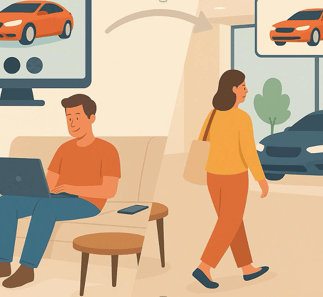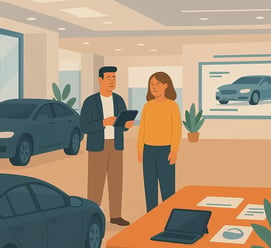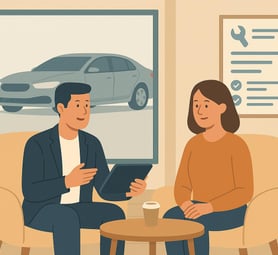Redefining the Customer-Centric Retail Experience
Future-Proofing Automotive Retail for a Global OEM
2/16/20253 min read
Buying a car is a big decision—one that blends emotion, financial commitment, and personal needs. But for many, the experience of visiting a dealership feels outdated, fragmented, and impersonal.
This initiative set out to redefine the future of automotive retail, creating a seamless, digital-first experience that meets modern consumer expectations while giving dealerships the tools to engage customers more effectively.
As a Business Designer & Strategist, my focus was on identifying the key moments that matter most to both customers and dealerships and ensuring that the new retail model enhances, not replaces, the human connection in car buying.
Reimagining the Dealership Experience: Key Moments for Buyers
From the moment a customer thinks about purchasing a new car to the day they drive off the lot, every interaction should feel intuitive, efficient, and personalized.
Before visiting the dealership:
Online research is now the first stop – Customers compare models, check financing options, and expect seamless digital-to-physical integration when they enter a showroom.
Dealership websites must do more – Instead of static pages, they should provide interactive experiences, allowing buyers to pre-configure their ideal car, book test drives, and explore financing.
Stepping into the dealership:
Personalized welcome – Customers should feel expected, not like they’re starting from scratch.
Seamless handover from digital to physical – Sales teams need access to the customer’s online research to tailor the experience.
Less paperwork, more guidance – Digital contracts, financing tools, and instant vehicle availability checks streamline the process.
The purchase decision moment:
Flexible buying options – Customers may want to complete their purchase in-store or continue online at their own pace.
Trust and transparency – Digital pricing breakdowns and side-by-side comparisons help eliminate decision fatigue.
Post-purchase engagement:
Handover experience – A more celebratory, memorable moment with digital onboarding (e.g., app setup, smart features walkthrough).
Aftersales connection – Service reminders, upgrade suggestions, and proactive engagement from the dealer instead of reactive fixes.
How We Designed for These Moments
The goal was to ensure that every step of the journey—both for the customer and the dealership team—was frictionless and future-proof.
Understanding the Pain Points & Opportunities
Through customer research and dealership insights, we mapped the as-is journey and identified the biggest hurdles:
• Customers feel overwhelmed by choices and lack transparent pricing.
• Digital tools and dealership interactions often feel disconnected.
• Sales teams struggle to personalize experiences because they lack access to customer preferences.
Designing the Future-State Journey
Using design sprints and journey mapping, we created a customer-first, digital-first retail model:
• Smart dealership ecosystems – Digital screens, self-service kiosks, and connected sales teams who know your preferences before you even sit down.
• Omnichannel retailing – The ability to switch between online and in-store seamlessly.
• Integrated financing & service – No more running numbers manually—automated systems provide transparent breakdowns instantly.
Giving Dealerships the Right Tools
For dealerships, the shift isn’t about removing the human touch—it’s about enhancing it.
The new model focused on:
• Sales team enablement – Giving staff access to customer profiles, financing scenarios, and trade-in evaluations in real time.
• Smoother operational workflows – Reducing inefficiencies in inventory, paperwork, and financing approvals.
• Stronger post-sale relationships – Helping dealers maintain engagement beyond the initial sale.


Testing & Refining with Real Customers
Pilot dealerships tested the model, allowing us to refine the journey based on actual customer interactions.
Metrics & feedback loops ensured that the new experience delivered real value—both in customer satisfaction and dealership efficiency.
My Role: Leading the Business Design Stream
As a Associate Manager I focused on:
• Customer Journey Mapping & Segmentation – Identifying key decision points for buyers and optimizing dealership interactions.
• Retail Strategy Development – Defining a hybrid digital-physical retail model.
• Stakeholder Management – Aligning dealership teams, IT, and operations for a smooth transition.
• Designing for Scalability – Ensuring the framework works across multiple markets.
The Impact: A Better Car Buying Experience for Everyone
Frictionless & Personalized Customer Journeys – Buyers feel empowered with transparency, personalization, and convenience.
Stronger Dealership Performance – Sales teams are better equipped to serve customers efficiently and proactively.
Scalable, Future-Proof Retail Model – A blueprint that works across different markets and dealership types.
This project set the stage for the next generation of automotive retail, ensuring that customers experience less hassle, more trust, and a seamless journey from digital browsing to driving home in their new car.



